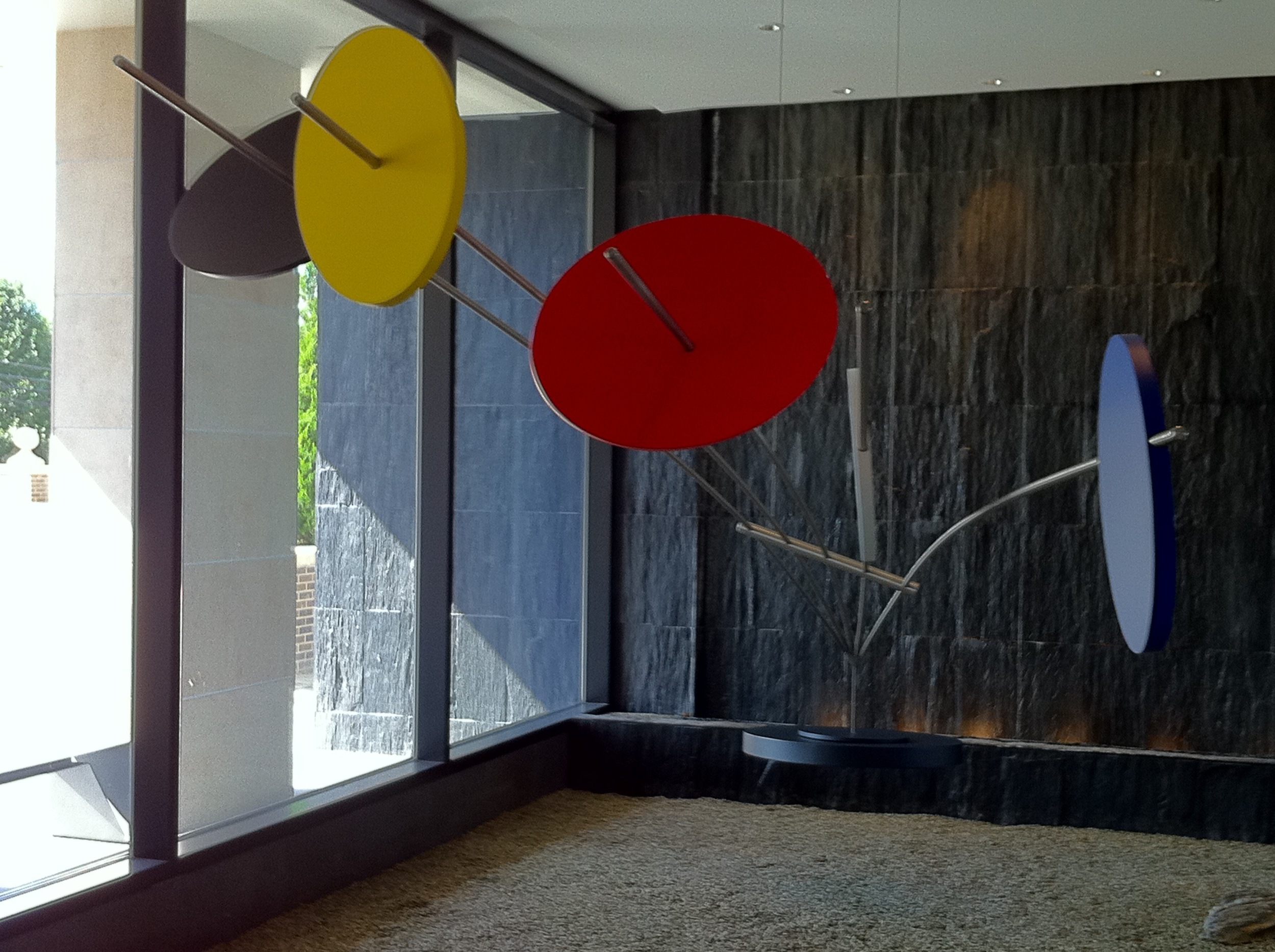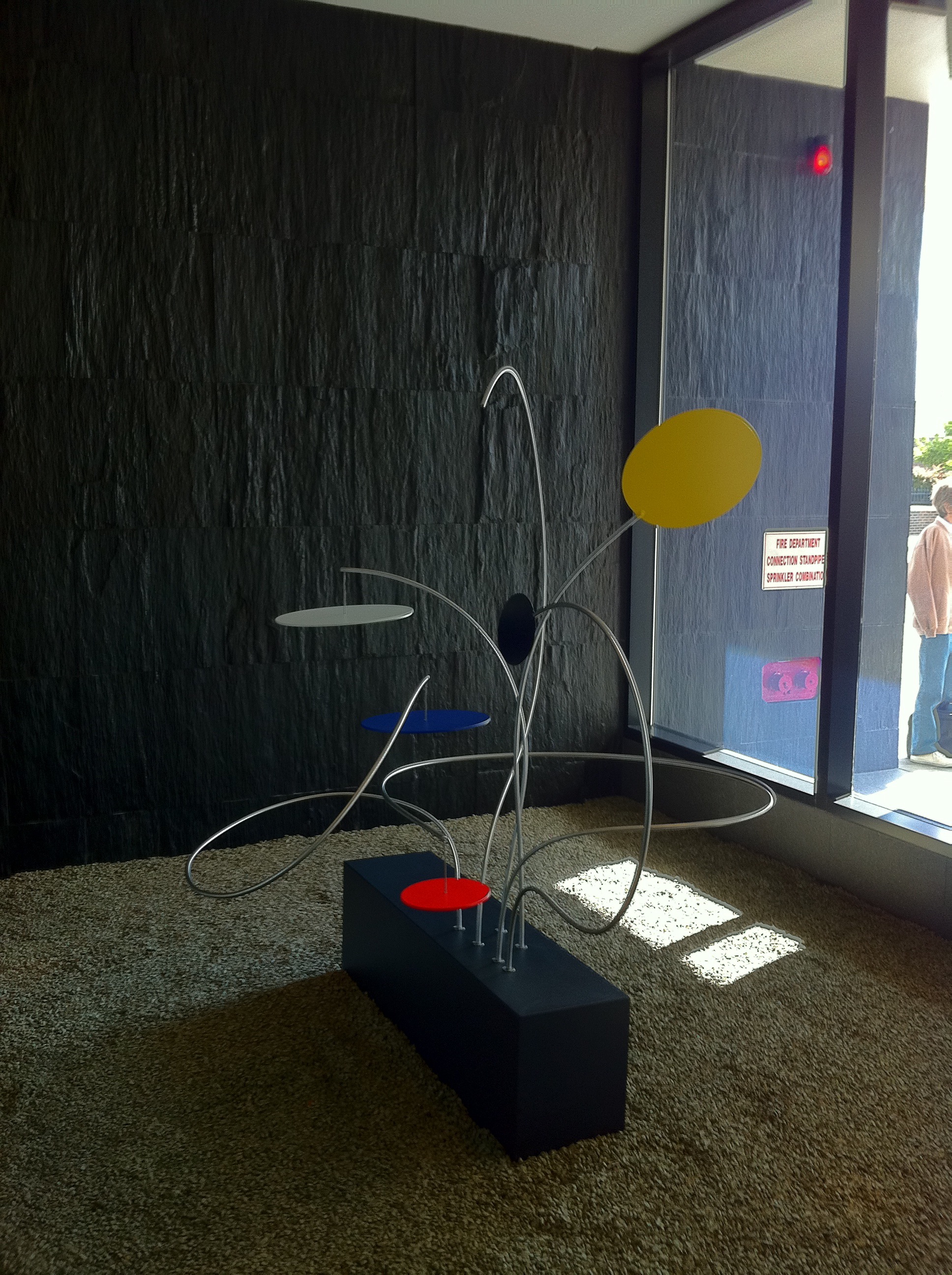And by the way, here are a few sketches of the Oman-themed SemiSwing from different vantage points.
SemiSwing (and a Social Studies Lesson)
We are making a SemiSwing for a fellow in Oman, which (unlike us) you probably already knew, is located right over by Saudi Arabia and Yemen.
The color scheme he's chosen is red, green, and white, which we happened to notice are the colors of the Oman flag.
Hanging 101
Confession: the trickiest part of an installation is almost always mounting the mobile to the ceiling. There are tons of types of ceilings, and since we don't usually visit the installation site beforehand, it's The Big Unknown.
We discovered this at our very first installation. We were installing several pieces at a rec center with a ceiling coated with an acoustic drywall, and we had no idea where the support beams were. Let's just say we learned more than a few important lessons that day. (Er, three days...)
The piece we created for the Rockingham Hospital last year had more than 50 mounting points. For each one, we had to remove the tiles from the drop ceiling, find a secure mounting point, and string the cable through the drop-ceiling tile. Matt spent a lot of time in that crawlspace. (See below.)
And at our last installation, the drop ceiling didn't have removable tiles, so Matt actually had to crawl through a three-foot crawlspace while staying on support beams to secure the sculpture's mounting point. Despite his grace, Matt decided he better not change careers to cat burglary.
I *Heart* NY
Matt and Ben just returned from an install right outside lovely New York City. Which certainly is different than lovely Sand Springs, Oklahoma. It was eye opening doing two similar installations back-to-back in two such different locations.
Maybe we're stating the obvious, but New York had a few more interesting sights to visit. But Sand Springs was a heckuvalot easier to navigate for little last-minute installation errands. Matt and Ben got the hang of New York traffic, though, and even navigated rush hour to the airport—just in the nick of time.
These pieces were installed in the lobby of a high-rise condo, so residents were shuffling in and out throughout the installation. And since New Yorkers are known for their candor, Matt and Ben certainly received plenty of real-time feedback. Mostly positive, thank goodness.
Brainstorming
We’re deep in the production phase of these stationary sculptures. And here’s an interesting logistical challenge we’ve faced: How do you get something 17 feet long cross country without spending a small fortune on freight? Break it down, of course. But the second caveat? It must be relatively simple to reassemble.
It took some serious brainstorming sessions, but we nailed down the perfect way to break down the rods in a way that significantly reduces the length, ensures a simple reassembly, and (most importantly) maintains the piece’s structural integrity. We’re always pleased what a little brainstorming can produce!
Inspiration
Matt's trip to the National Gallery last month provided an inspiration breakthrough for the stationary sculptures we're currently working on. He noticed that Calder's huge mobile in the lobby was actually scaled up from a small mobile: everything was proportional—the wires, the shapes, everything was huge. When scaled up, the shapes were no longer flat, but had enough thickness to be visually interested from every plane.
So, Matt did the same thing: when scaling up the dimensions of our sculpture's initial model, he ensured the shapes had enough thickness to look substantial from every direction. But it threw off the piece's balance. So we remedied it by adding a small hole (which will be concealed when complete) to add counterweights in the hollow shapes.
And now we wonder whether Calder's mobile needed counterweights, too...
Sand Springs High School
It's always a relief when we install and complete a project without a hitch. In this case, Matt and Ben just returned from lovely Sand Springs, Oklahoma, where they installed this mobile in the local high school's new fine arts facility. Here are photos of the installation process.
The Master
Matt and family visited Washington D.C. over Memorial Day weekend. Their priority destination was the Calder exhibit at the National Gallery, which they unanimously agreed was stunning.
And the gigantic mobile in the lobby? Also stunning. And gigantic. After a lengthy observation, Matt's daughter declared, "Daddy, I can't get enough of this mobile."
Powder Coating 102
Here’s an overview of the actual powder-coating process:
- Metal surfaces are thoroughly cleaned
- Powder coating is applied with an electrostatic (or corona) gun. Thanks to the magic of molecular physics, the electrically charged powder sticks to the metal object.
- The object is baked at about 400 degrees Fahrenheit, which causes the powder to melt into a uniform film.
- The object is cooled, turning the film into a hard coating.
Many thanks to Derek, Dave, and Juan at Portland Powder Coating for patiently educating us on the process over the years—and for producing such consistent, high quality work!
Powder Coating 101
Our Sand Springs, Oklahoma project required a serious powder coating (preceded by some serious prep work, as pictured above), so we’ve spent a lot of time with our powder coating guys over the past few weeks.
Why powder coat? Glad you asked. Powder coating is a process we highly prefer on our large-scale projects. It’s an industrial-grade coating that’s applied as a dry powder and then cured under heat to form a “skin” that, once dry, is much tougher and more durable than conventional paint.
Since powder coating doesn't require a solvent, it has several advantages, both environmental and aesthetically over good old paint:
- It produces practically no waste, since overspray can be recycled
- It emits practically no volatile organic compounds
- It produces much less hazardous waste
- It creates a thicker coating without running or sagging
- It creates a uniform finish, especially between horizontally and vertically coated surfaces
The downsides? Well, it costs more than paint. And it's not necessarily convenient to schlep stuff across town to our powder coaters. But all that is relatively inconsequential considering the high-quality finish it adds to our projects. And that makes the perfectionists around here happy.













